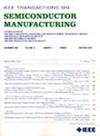Throughput and Quality Optimized Down-Selection of Overlay Measurement Markers for Robust Control of the Maximum Overlay Error in a Pattern Layer in Photolithography Processes
IF 2.3
3区 工程技术
Q2 ENGINEERING, ELECTRICAL & ELECTRONIC
引用次数: 0
Abstract
This paper presents a metaheuristic optimization-based approach for selecting a pre-determined number of measurement markers from the set of available markers that optimizes the performance of the recently introduced robust用于光刻过程中图案层最大覆盖误差鲁棒控制的覆盖测量标记的选择
本文提出了一种基于元启发式优化的方法,用于从可用标记集中选择预先确定数量的测量标记,以优化最近引入的鲁棒${\mathrm { L}}^{\infty }$范数覆盖控制算法的性能,该算法鲁棒地最小化给定模式层上的最差覆盖误差。然后将此优化用于实验设计(DOE)设置,以构建可定制目标函数的易于处理的回归模型,该模型包含质量损失的成本效应和为鲁棒覆盖控制而选择的标记的下选择所产生的吞吐量效益。使用该模型,可以快速确定任何一组成本参数的标记的最佳比例,并且可以向下选择构成该比例可用标记的最优子集,以最大限度地提高所得到的鲁棒覆盖控制器的性能。利用半导体制造工厂的覆盖数据和模型来评估新提出的检测和控制策略。结果清楚地表明,与传统的R2R控制相比,新型策略下选择测量标记加上鲁棒覆盖控制可以在不降低质量的情况下大大提高吞吐量。在两种成本-效果参数情况下,验证了基于doe的优化方法的可行性。
本文章由计算机程序翻译,如有差异,请以英文原文为准。
求助全文
约1分钟内获得全文
求助全文
来源期刊

IEEE Transactions on Semiconductor Manufacturing
工程技术-工程:电子与电气
CiteScore
5.20
自引率
11.10%
发文量
101
审稿时长
3.3 months
期刊介绍:
The IEEE Transactions on Semiconductor Manufacturing addresses the challenging problems of manufacturing complex microelectronic components, especially very large scale integrated circuits (VLSI). Manufacturing these products requires precision micropatterning, precise control of materials properties, ultraclean work environments, and complex interactions of chemical, physical, electrical and mechanical processes.
 求助内容:
求助内容: 应助结果提醒方式:
应助结果提醒方式:


